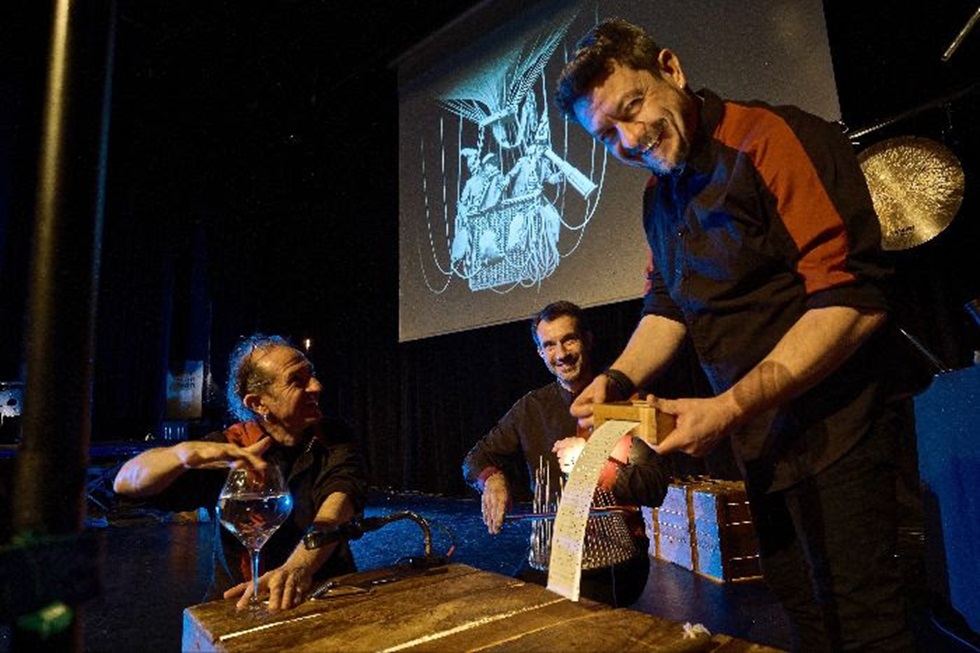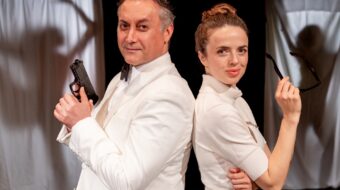
Although Americans may have largely forgotten about Georges Méliès, every moviegoer owes this French motion picture pioneer an immense debt of gratitude. Along with a handful of other film forerunners—including the Lumiere Brothers (for whom a cinema in Beverly Hills is named), Thomas Edison, Edwin S. Porter, D.W. Griffith (whose creative contribution to the cinematic syntax and art form was as great as his despicable, rancid racism was odiously egregious)—Méliès tremendously enriched the nascent silver screen’s aesthetic and experience. French composer Jean-François Alcoléa and two other musicians are doing film lovers a fabulous service by reviving 11 Méliès shorts set to a scintillating score that is arguably as aurally inventive as Méliès’s original silent films were visually innovative, with the trio’s delightful program Right in the Eye, a “Live Movie-Concert of George Méliès Films.”
Starting in 1896, Méliès began cranking out hundreds of shorts—call it the other MCU, the “Méliès Cinematic Universe,” without which, had it not existed, Marvel’s latter-day version may never have come into being. Keep in mind that Méliès’s filmmaking started only about a year after movies were invented. Previously a magician and illusionist, Méliès imbued his cinematic sensibility with that magical mentality, pioneering special effects that cineplex popcorn munchers can still revel in today. Méliès’s FX additions to and innovations for the newborn screen’s lexicon include: Stop motion photography, multiple exposures, dissolves, time lapse cinematography, substitution splices and even color (by painstakingly hand painting frames of celluloid!), and more.
1898’s The Four Troublesome Heads aka The Magician and His Three Heads, which is screened during the Right in the Eye extravaganza, stars the director himself (Méliès appeared in almost 200 productions) and is a stellar example of the helmer’s versatile cinematic sleight of hand (and eye). In a sense, Méliès made a kind of CGI, but instead of computers, he used something far greater, a boundless imagination that fueled breathless originality. And as a discoverer of the motion picture medium, Méliès’s shorts have that jaunty attitude of exploration, leavened by a magician’s trickster psychology and above all, wit.

Two of Méliès’s most famous films are filled with an adventurous spirit, depicting expeditions embarking on voyages of discovery, 1902’s fabled A Trip to the Moon and 1904’s The Impossible Voyage, both inspired by France’s sci-fi master Jules Verne (Méliès sometimes adapted literary classics such as Gulliver’s Travels for the screen). One can tell that Méliès delighted in his artistic explorations and unfailingly transmits that ambiance of sheer delight to viewers with his impish sense of humor. (Although it should be noted that Méliès’s filmic flights of fancy could be macabre, in a similar way that nightmares with their startling dreamlike graphics can be. Examples include 1903’s The Damnation of Faust and 1911’s The Hallucinations of Baron Munchausen.)
It’s amusing to reflect that in written English, the audacious magician-cum-filmmaker’s name could be broken up to be “Me-Lies.” In a sense, that was indeed what Méliès was doing, as he co-invented and co-created the art form, using the new-fangled movies to spin “lies,” cinematic phantasmagorical imagery for storytelling in a new visual medium based on the illusion of the persistence of vision.
However, for all his infinite innovations, Méliès, who stopped filmmaking in 1913 (alas!), never created a single movie with synchronized sound. But Alcoléa’s trio, which performs live throughout the screening of Right in the Eye’s 11 shorts, provides an eclectic soundtrack to what can’t rightfully be labeled as “silent” films per se in this show. The three musicians perform 50 instruments throughout the cinematic spectacle, rendering sound that’s as unique and creative as the imagery their music accompanies on the big screen. According to a press release, the virtuosos’ “extraordinary range of instruments [includes] piano, a soundboard, percussion and guitar; aquaphone (marine harp), theremin, melodica, glockenspiel; and objects of everyday life such as stemware [musical glasses], circular saws, whistles, flying plates and takeaway food lids,” and god knows what else. Along with Alcoléa, they include Fabrice Favriou playing drums and guitar, and Thomas Desmartis tickling the keyboard, objects and sound.
The spectacle’s title, Right in the Eye, likely refers to the single most unforgettable, indelible image of Méliès’ entire oeuvre, derived from A Trip to the Moon (see it here). A rocket ship fired by a gigantic cannon on Earth that’s aimed at the lunar surface lands smack dab in the eye of the proverbial “man in the moon.” Interestingly, as I recall, Méliès’s most famous film isn’t, for some reason, even in Right in the Eye’s selections, although I believe there’s a glimpse of the shot of the spaceship in the moon’s eye taken from this film.
Alcoléa’s live “Movie-Concert” has done the most to revive interest in and movie memories of Méliès since Ben Kingsley portrayed Georges in 2011’s Hugo, directed by Martin Scorsese, who is not only a motion picture maestro but a walking, talking repository of film culture and history. Currently embarking on a magical mystery tour of its own across North America, Right in the Eye was presented in L.A. before a nearly sold out, enthusiastic audience at the 220-seat Théâtre Raymond Kabbaz, named after the president and founder of Le Lycée Français de Los Angeles. The aural-cinematic spectacle took about 90 minutes, including encores, and earned well-deserved standing ovations. You don’t have to be a film historian or Francophone to enjoy this show, and children of all ages should not miss it if it plays in a venue near you during its tour. A splendid time shall be had by all. Bravo!
For more info, including the schedule of the USA and Canada tour of Right in the Eye, Live Movie-Concert of George Méliès Films, see here.
Fun Fact: George Méliès’s older brother, Gaston, was also a producer/director who, starting around 1913, sailed to the South Pacific and Asia with a troupe of French filmmakers, shooting shorts with Indigenous people made on location in Tahiti (A Ballad of the South Seas), New Zealand/Aotearoa (Hinemoa), Australia (Captured by Aboriginals), Indonesia (It Happened in Java), Cambodia (The Ruins of Angkor-Thom), and others.
We hope you appreciated this article. At People’s World, we believe news and information should be free and accessible to all, but we need your help. Our journalism is free of corporate influence and paywalls because we are totally reader-supported. Only you, our readers and supporters, make this possible. If you enjoy reading People’s World and the stories we bring you, please support our work by donating or becoming a monthly sustainer today. Thank you!












Comments